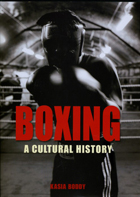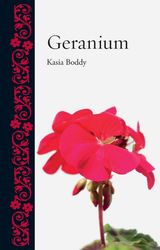3 books about Boddy, Kasia

Boxing
A Cultural History
Kasia Boddy
Reaktion Books, 2008
Boxing is one of the oldest and most exciting of sports: its bruising and bloody confrontations have permeated Western culture since 3000 BC. During that period, there has hardly been a time in which young men, and sometimes women, did not raise their gloved or naked fists to one other. Throughout this history, potters, sculptors, painters, poets, novelists, cartoonists, song-writers, photographers and film-makers have been there to record and make sense of it all.
In her encyclopaedic investigation, Kasia Boddy sheds new light on an elemental sports and struggle for dominance whose weapons are nothing more than fists. Boddy examines the shifting social, political and cultural resonances of this most visceral of sports, and shows how from Daniel Mendoza to Mike Tyson, boxers have embodied and enacted our anxieties about race, ethnicity, gender and sexuality. Looking afresh at everything from neoclassical sculpture to hip-hop lyrics, Boxing explores the way in which the history of boxing has intersected with the history of mass media, from cinema to radio to pay-per-view. The book also offers an intriguing new perspective on the work of such diverse figures as Henry Fielding, Spike Lee, Charlie Chaplin, Philip Roth, James Joyce, Mae West, Bertolt Brecht, and Charles Dickens.
An all-encompassing study, Boxing ultimately reveals to us just how and why boxing has mattered so much to so many.
[more]

Boxing
A Cultural History
Kasia Boddy
Reaktion Books, 2008
Boxing is one of the oldest and most exciting of sports: its bruising and bloody confrontations have permeated Western culture since 3000 BC. During that period, there has hardly been a time in which young men, and sometimes women, did not raise their gloved or naked fists to one other. Throughout this history, potters, sculptors, painters, poets, novelists, cartoonists, song-writers, photographers and film-makers have been there to record and make sense of it all.
In her encyclopaedic investigation, Kasia Boddy sheds new light on an elemental sports and struggle for dominance whose weapons are nothing more than fists. Boddy examines the shifting social, political and cultural resonances of this most visceral of sports, and shows how from Daniel Mendoza to Mike Tyson, boxers have embodied and enacted our anxieties about race, ethnicity, gender and sexuality. Looking afresh at everything from neoclassical sculpture to hip-hop lyrics, Boxing explores the way in which the history of boxing has intersected with the history of mass media, from cinema to radio to pay-per-view. The book also offers an intriguing new perspective on the work of such diverse figures as Henry Fielding, Spike Lee, Charlie Chaplin, Philip Roth, James Joyce, Mae West, Bertolt Brecht, and Charles Dickens.
An all-encompassing study, Boxing ultimately reveals to us just how and why boxing has mattered so much to so many.
[more]

Geranium
Kasia Boddy
Reaktion Books, 2013
They are sometimes called storksbills and originated in South Africa. They may be star-shaped or funnel-shaped, and they range in color from white, pink, and orange-red to fuchsia and deep purple. The geranium and its many species, much loved and also much loathed, have developed since the seventeenth century into one of the most popular garden plants. In this book, Kasia Boddy tells the story of geranium’s seemingly inexorable rise, unearthing the role it has played in everything from plant-hunting and commercial cultivation to alternative medicine, the philanthropic imagination, and changing styles in horticultural fashion.
Boddy shows how geraniums became the latest fad for wealthy collectors and enterprising nurserymen after they were first collected by Dutch plant-hunters on the sandy flats near present-day Cape Town. She explains that the flower would not be rare for long—scarlet hybrids were soon found on every cottage windowsill and in every park bedding display, and the backlash against the innocent plant followed quickly on the heels of its ubiquity. Today, geraniums can be found throughout the world, grown as annuals in the regions too cold for them to regenerate. In addition to exploring the history of geraniums, Boddy reveals the plant’s other uses, including how they are cultivated and distilled for their scents of citrus, mint, pine, rose, and various spices to use in perfumes. With their edible leaves, they are also used to flavor desserts, cakes, jellies, and teas, and some people believe that certain species provide an effective treatment for a cough.
Featuring over one hundred illustrations, Geranium shows how the plant is portrayed in painting, literature, film, and popular culture, and provides an intriguing example of the global industrialization of plant production.
[more]
READERS
Browse our collection.
PUBLISHERS
See BiblioVault's publisher services.
STUDENT SERVICES
Files for college accessibility offices.
UChicago Accessibility Resources
home | accessibility | search | about | contact us
BiblioVault ® 2001 - 2024
The University of Chicago Press









